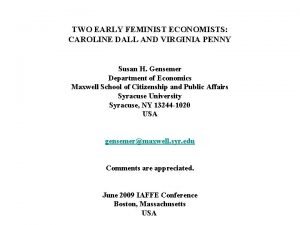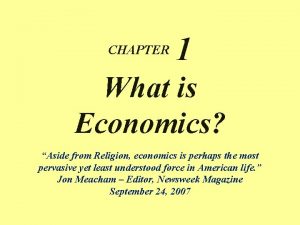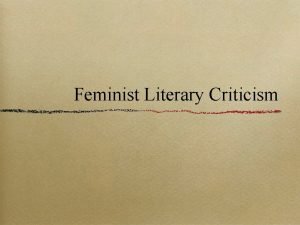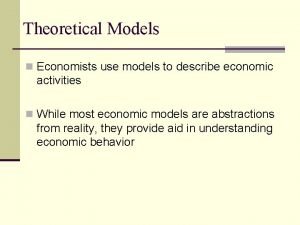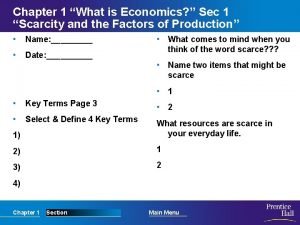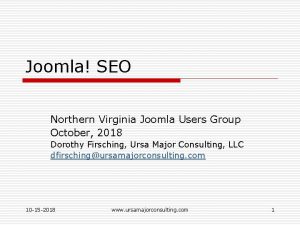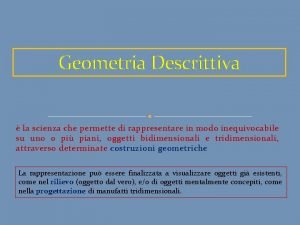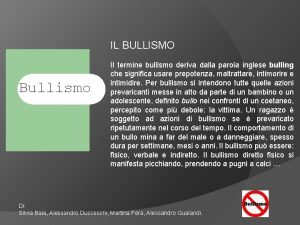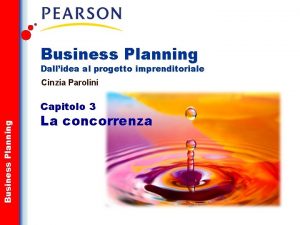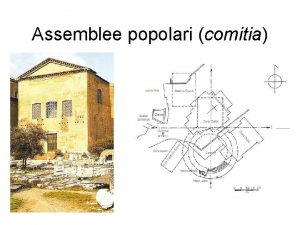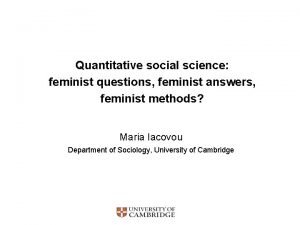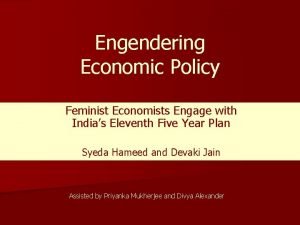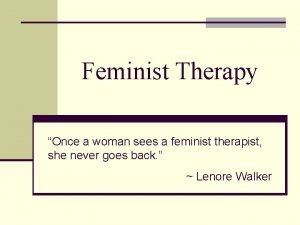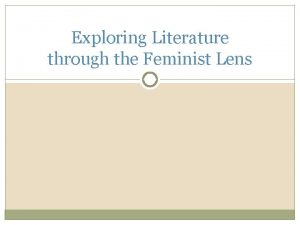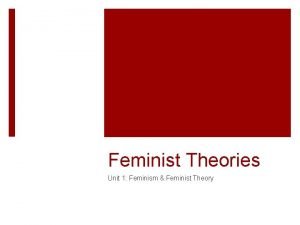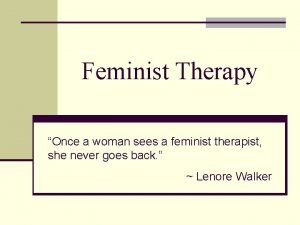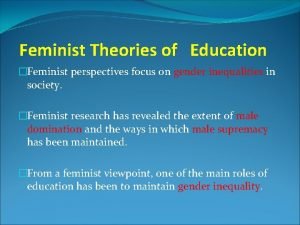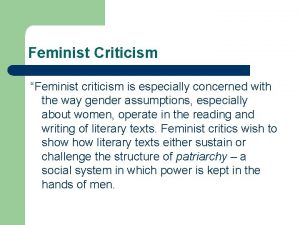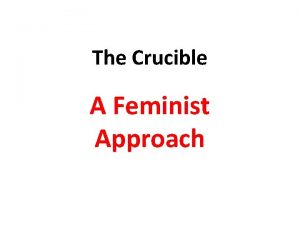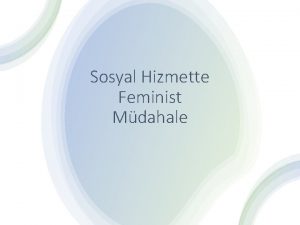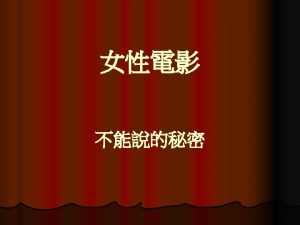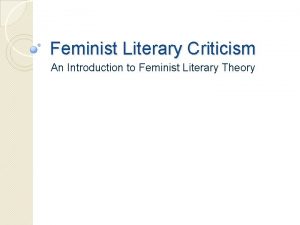TWO EARLY FEMINIST ECONOMISTS CAROLINE DALL AND VIRGINIA








![• Dall reacted in her journal, September 21, 1890: • [M]y life is • Dall reacted in her journal, September 21, 1890: • [M]y life is](https://slidetodoc.com/presentation_image/a49ca84e63b515f229c533d59d902f69/image-9.jpg)


















- Slides: 27

TWO EARLY FEMINIST ECONOMISTS: CAROLINE DALL AND VIRGINIA PENNY Susan H. Gensemer Department of Economics Maxwell School of Citizenship and Public Affairs Syracuse University Syracuse, NY 13244 -1020 USA gensemer@maxwell. syr. edu Comments are appreciated. June 2009 IAFFE Conference Boston, Massachusetts USA

INTRODUCTION Caroline Dall (1822 -1912) and Virginia Penny (1826 -1913) and have been identified as the two earliest American feminist economists. Caroline Dall (1822 -1912) Virginia Penny (1826 -1913) References • Robert Dimand, Nineteenth Century American Feminist Economics: From Caroline Dall to Charlotte Perkins Gilman, American Economic Review 90 (2), Papers and Proceedings, 2000

Caroline Dall Biography • born in Boston, Massachusetts, USA, on June 22, 1822, and lived there most of her life • she was the eldest of eight children • well educated by governesses and in private schools • was vice-principal of a girls’ school for a short time in Washington, DC • married to a Unitarian minister, two children; her husband became a missionary to India in 1855, never returning permanently to the USA • supported herself and family by taking in boarders, receiving her father’s financial help (including an inheritance), and writing • cofounder of American Social Science Association, member of its executive committee, and its main librarian • she lived in Washington, DC, the last few decades of her life, where her son was employed at the Smithsonian Institute • she died on Dec 12, 1912

Books • Women’s Right to Labor; or Low Wages and Great Sins, 1860 • dedicated to Anna Jameson • delivered as three lectures • much like Mary Wollstonecraft’s A Vindication of the Rights of Woman, specific to the right of women to take a place in the paid labor market • similar to Priscilla Wakefield’s Reflections on the Present Condition of the Female Sex, with Suggestions for Improvement, 1798 • The College, The Market, The Court, 1867 • dedicated to Lucretia Mott • this trilogy of subjects (women’s education, paid employment, and laws) incorporated the first book; delivered as nine lectures • aside from addressing each subject, she noted the interaction across those spheres References • Helen R. Deese, Daughter of Boston, 2005 • Robert Dimand, Caroline Dall, in Dimand et al. (eds), A Biographical Dictionary of Women Economists, 2000 • Edward T. James et al. (eds), Notable American Women

Virginia Penny Biography • born on January 18, 1826, in Louisville, Kentucky, USA • eldest of five children, the only girl • well educated and active in Louisville literary circles; received degree from Female Steubenville Seminary, Steubenville, Ohio • taught for over nine years in seminaries and private schools in Ohio, Illinois, and Missouri; taught in Louisville public schools • supported herself as a correspondent of newspapers in Louisville, Kentucky, and Cincinnati, Ohio • never married • lived in Louisville, Kentucky; Cincinnati, Ohio; Chicago, Illinois; and New York City • died April 4, 1913, New York City

Books • The Employments of Women: A Cyclopedia of Women’s Work, 1863 (later retitled How Women Can Make Money) • dedicated “To Worthy and Industrious Women in the United States Striving to Earn a Livelihood” • an encyclopedic treatment of over five hundred possible occupations for • occupations encompassed artificial eye manufacture, rag collection, teaching, and medicine • wages, necessary training, seasonality of employment, likelihood of employment for women, and health risks were given for the various occupations • research underlying the book • researched libraries in Louisville, St. Louis, Philadelphia, and New York • sent thousands of questionnaires to employers • visited thousands of places of employment

• Her second book, Think and Act: A Series of Articles Pertaining to Men and Women, Work and Wages, 1869 • a collection of over one hundred short essays, many of which had appeared in newspapers and other outlets, and most of which have economic content References • Susan Gensemer, Virginia Penny, in Dimand et al. (eds), A Biographical Dictionary of Women Economists, 2000 • Susan Gensemer, Virginia Penny, Working Paper, 2009

WHO WAS THE PIONEER IN AMERICAN WOMAN’S LABOR? A competition arose between Dall and Penny for the position • Journalists publicized Penny’s impoverished condition, citing her as a pioneer in woman’s labor and calling for contributions toward her support • Jane Cunningham Croly (the journalist Jennie June) in the Woman’s Cycle, September 4, 1890: • The first book ever written in the interests of the industries of American women was by Miss Virginia Penny, who in 1863, published The Employments of Women. The book required much time, labor, and patient research. . . [S]he has labored and now finds herself without means or a home. Two hundred dollars. . . will secure her a home. . .
![Dall reacted in her journal September 21 1890 My life is • Dall reacted in her journal, September 21, 1890: • [M]y life is](https://slidetodoc.com/presentation_image/a49ca84e63b515f229c533d59d902f69/image-9.jpg)
• Dall reacted in her journal, September 21, 1890: • [M]y life is spent chiefly in correspondence about the new house, and in writing to and about housekeepers, but yesterday I contrived to write Jennie June – about the publication of [my book] “Woman’s Right to Labor. ” My children thought that I ought not to let a recent statement of hers (in the Woman’s Cycle) stand – It was to the effect that Virginia Penny’s book was the first book ever printed relating to the industries of women - ! Virginia, who must have given Jennie this item, wisely forgets coming to ask my assistance in the sale of her book long after “Woman’s Right to Labor” was published. She [Virginia] would never had heard of my existence except for the Hovey prize which was awarded my book immediately on its publication.

• A few years before, Illinois journalist Emily A. Kellogg had interviewed Penny in Chicago. A Woman’s Sacrifice appeared in the Chicago Herald, 1887: • Virginia Penny, striving to give women a larger entrance into the business of the world, with better opportunities for labor and more generous pay, has been a pioneer and laborer in the field of advancement and progress for women • Dall was aware of Penny’s poverty • Dall and Penny had seen each other at the Social Science meetings in Cincinnati, Ohio, in May 1878. At the end of one of the days of the convention, Dall wrote in her journal that “poor Virginia Penny” took Dall to tea at a restaurant; Dall “went without a good supper to do it. ” Dall continued, “I know the poorest people are made poorer if you refuse their courtesies. I have sincere respect for the child. ”

The pleas of journalists, seeking financial support for Penny, continued for about fifteen years


References • The Woman’s Cycle, September 4, 1890 • Caroline Dall papers at the Massachusetts Historical Society • Newspapers

Many Decades Before • This competition had actually started many decades before • Thomas Wentworth Higginson (a founder of the American Social Science Association) June 20, 1867, in comments written to Caroline Dall regarding the manuscript for her second book • I am surprised that you nowhere speak of Virginia Penny’s Cyclopedia of Women’s Employments, which is so very valuable, and cost great labor. I furnished her with much matter which she worked over thoroughly, but the book receives no attention. • Caroline Dall response in her personal notes about Higginson’s comments • Don’t think it [Virginia’s book] good. • The errata were being corrected when this note arrived. I do not speak of V. P. because I do not think her book valuable.

• Virginia Penny letter to Caroline Dall, Aug 9, 1867 • I think it strange that in setting forth the employments that have opened, are opening, and may open to women you did not mention my work The Employments of Women containing accounts of over 500 occupations and which cost me an incredible amount of time, money, and labor (with the loss of my health) to collect, describe, etc. • Thomas Wentworth Higginson January 28, 1868, letter to Caroline Dall • I wish you had spoken of Virginia Penny (Employments of Am. Women, Boston: Walker, Wise, and Co, 1863) whose great and unrequited labors deserve acknowledgment from one following in the same path. Her book contains a greater volume of information on the subject than any known to me in any language, and as accurate as can be expected of any such book. References • Caroline Dall papers at the Massachusetts Historical Society

CAROLINE DALL AND LABOR MARKETS FOR WOMEN • “Woman’s Claims to Labor • First, The absolute necessity of bread, • Second, A natural ability. . . an attraction inherent in ability • Third, An absolute want of the moral nature. ” • Work is honorable; all women, married or not, should work (although she didn’t offer specific ideas about how this could work) • All women should have access to money • Women have done the least desirable work throughout history • Linked labor markets to laws and education for women • laws and customs cripple women; they keep women subordinate; lack of property rights act as a disincentive for women to work • need better education for the labor force • There should be a labor exchange for women • Women should oversee women’s work

• Problems with women’s labor markets • standard laws of political economy do not apply to women’s labor and women’s wages because of legal and social restrictions on women • women suffer from discrimination • women’s low wages in part explained by lack of respect for women; as women are more respected, their wages will increase • upper class women should work for money; this will help to create respect for women’s work • more respect will be developed for women as they show their ability to work • women should not give away their work for free; their doing so depresses the estimate of woman’s ability, and her wages • men oppose women in the labor market • men hold even women’s jobs • women’s labor markets are overly crowded, and this is one cause of prostitution References • Women’s Right to Labor; or Low Wages and Great Sins, 1860 • The College, The Market, The Court, 1867

VIRGINIA PENNY AND LABOR MARKETS FOR WOMEN • Women must have working rights: “Society has deprived women of some of the best employments for earning a livelihood, and so far it has wronged them. . . They are persecuted. . . ” • On the crowding in women’s labor markets • women should enter men’s jobs and demand fair wages • men should exit jobs that are not “manly” • few markets are open to women because of “prejudice, opposition, and the want of training” • women’s lack of job options is one cause of prostitution • On male-female wage differentials • a woman “well knows that for the same amount of work. . . she has received less remuneration” • women make one third to one half what men make • “A woman may be defined to be a creature that receives half price for all she does, and pays full price for all she needs”

• Discrimination: “Selfishness and prejudice have closed. . . many employments” for women • employers may not hire women due to negative affects from employees or other employers • Men have retained a monopoly over jobs through the support of the public • Supported government labor market intervention • men monopolizing women’s jobs should be taxed fifty per cent • legislatures ought to pass laws supporting equal pay for equal work • the government ought to award contracts only to those firms employing women and paying them a reasonable wage • government should have funds available to furnish women with remunerative employment • the government should levy taxes to establish schools for teaching females mechanical arts • men opposing women’s fair employment conditions should be arrested • the government should financially support women if labor markets do not operate fairly and result in adequate wages to women

• Feedback effects of labor market on women and society • women’s low wages diminish their “self-respect and ambition” • women underestimate their work relative to men • women’s low wages force them into the marriage market • disincentive to obtain human capital

• Women can help themselves and other women: • women with other financial support should not undercut other women on wages • women should purchase articles made by other women • women should purchase at stores where women receive reasonable wages and are treated well • working women should form unions and strike • women who employ women should be supportive of them (They should follow the “motto. . . ‘Am I not a woman and a sister? ’”) • women with money should not bargain too hard for articles made by other women • mothers should raise daughters to seek financial independence • women could form partnerships and go into business for themselves • women should emigrate to areas where labor and marriage markets are not so crowded • women could go into less crowded avenues of employment • women should open employment for other women • women should not do secret work; it depresses women’s wages

• Advice to females’ relatives • girls should be raised to be self-reliant with the idea of making their information pay • parents should seek practical education and apprenticeships for their daughters • Society should help women in labor markets • there should be employment societies for women and homes for unemployed women • philanthropists should open industry to girls • men could migrate West and get into agriculture • women should be encouraged by superiors on the job as men are encouraged

• Discussed women’s material support outside of labor markets • husbands should be forced to support wives and children • single men should be taxed • suggested that poor women in the United States receive mother provisioning as did mothers in Vienna References • The Employments of Women: A Cyclopedia of Women’s Work, 1863 • Think and Act: A Series of Articles Pertaining to Men and Women, Work and Wages, 1869

CONCLUSION If I had to choose one pioneer in American women’s labor, I would choose Virginia Penny • she gave an original, detailed look at women’s labor markets of her day • her first work was certainly a pioneering study of women’s labor markets • Higginson's description of Penny's book as “contain[ing] a greater volume of information on the subject than any known … in any language” at that time is appropriate • she offered policy prescriptions for women’s relief in labor markets (and women’s inferior access to resources otherwise) • her descriptions resonate with even today’s writers, as a review of the citations of her work shows

The strength of Dall’s contribution • lays in her first book as a treatise demanding that labor markets be open to women • lays in noting the interaction across areas in The College, The Market, The Court, 1867 Overall, I would argue that their approaches were complementary • Dall argued for woman’s right to paid labor, and emphasizes her legal and educational disabilities in pursuing it • Penny gave an up close, personal, and comprehensive look at women’s labor markets

REFERENCES Dall, Caroline. 1867. The College, The Market, The Court. _____. 1860. Women’s Right to Labor; or Low Wages and Great Sins. Deese, Helen. 2002. Caroline Healey Dall and the American Women’s Movement, 1848 -75, American Nineteenth Century History 3 (3), Fall 2002, 1 -28. Deese, Helen (ed). 2005. Daughter of Boston: The Extraordinary Diary of a Nineteenth-century Woman Caroline Healey Dall. _____. 2006. Selected Journals of Caroline Healey Dall, vol I: 1838 -1855. Dimand, Robert. 2000. Caroline Wells Healey Dall, in A Biographical Dictionary of Women Economists. _____. 2000. Nineteenth Century American Feminist Economics: From Caroline Dall to Charlotte Perkins Gilman, American Economic Review 90 (2), Papers and Proceedings. Dimand, Robert, et al. (eds. ), 2000. A Biographical Dictionary of Women Economists. Gensemer, Susan. 2000. Virginia Penny in Dimand, Robert, et al. (eds) 2000. Gensemer, Susan. Virginia Penny, Working Paper, 2009. Leach, William. 1980. True Love and Perfect Union: The Feminist Reform of Sex and Society. Penny, Virginia. [1863] 1971. The Employments of Women: A Cyclopaedia of Woman’s Work. Boston: Walker, Wise and Co. Reprinted as How Women Can Make Money with an introduction by Leon Stein and Philip Taft. New York: Arno and the New York Times. ___. [1869] 1971. Think and Act: A Series of Articles Pertaining to Men and Women, Work and Wages. Philadelphia: Claxton, Remsen, and Haffelfinger. Reprinted by New York: Arno and the New York Times. Stein, Leon, and Philip Taft. 1971. “Introduction” to How Women Can Make Money.

OTHER RESOURCES Caroline Wells Healey Dall Papers 1811 -1917, Massachusetts Historical Society. NEWSPAPER ARTICLES “A Woman’s Sacrifice, ” Chicago Sunday Herald, July 10, 1887. The Woman’s Cycle Sept 4, 1890. “A Pioneer in Woman’s Work, ” Olean (New York) Weekly Democrat, Thurs, Nov 20, 1890. “Virginia Penny in Need: Her Arduous Labors in Behalf of Workingwomen, ” New York Times, Jan 22, 1893. “Work for Women: How New Fields of Employment Have Been Opened, ” Worcester Daily Spy, Jan 22, 1893. “Woman Worker in Want, ” New York Times, Aug 1, 1902.
 Caroline dall
Caroline dall To help unscramble cause and effect, economists
To help unscramble cause and effect, economists Feminist literary criticism ppt
Feminist literary criticism ppt Pure competition
Pure competition International association of maritime economists
International association of maritime economists Economists use models to
Economists use models to Yogesh uppal
Yogesh uppal Chapter 1 section 1: scarcity guns or butter answer key
Chapter 1 section 1: scarcity guns or butter answer key Early cpr and early defibrillation can: *
Early cpr and early defibrillation can: * Seo northern virginia virginia
Seo northern virginia virginia Dal bello al vero
Dal bello al vero Vista frontale laterale e dall'alto
Vista frontale laterale e dall'alto Alessandra spreafico
Alessandra spreafico Domenico dall'olio
Domenico dall'olio Infinitamente piccolo infinitamente grande
Infinitamente piccolo infinitamente grande Tara dall md
Tara dall md La parola bullismo deriva dall'inglese
La parola bullismo deriva dall'inglese Dall'aurora al tramonto canto ingresso
Dall'aurora al tramonto canto ingresso Business planning. dall'idea al progetto imprenditoriale
Business planning. dall'idea al progetto imprenditoriale Fuga in egitto annibale
Fuga in egitto annibale Nella cmr la presa in carico è un atto complesso
Nella cmr la presa in carico è un atto complesso La forza motrice è la forza centrifuga generata dal motore
La forza motrice è la forza centrifuga generata dal motore Distributore a mano impianto frenante
Distributore a mano impianto frenante Capability approach tfa
Capability approach tfa Dall'albero alla carta
Dall'albero alla carta Dal bello al vero
Dal bello al vero Pareggiate imbianchino
Pareggiate imbianchino Quale continente è tagliato a metà dall'equatore
Quale continente è tagliato a metà dall'equatore
